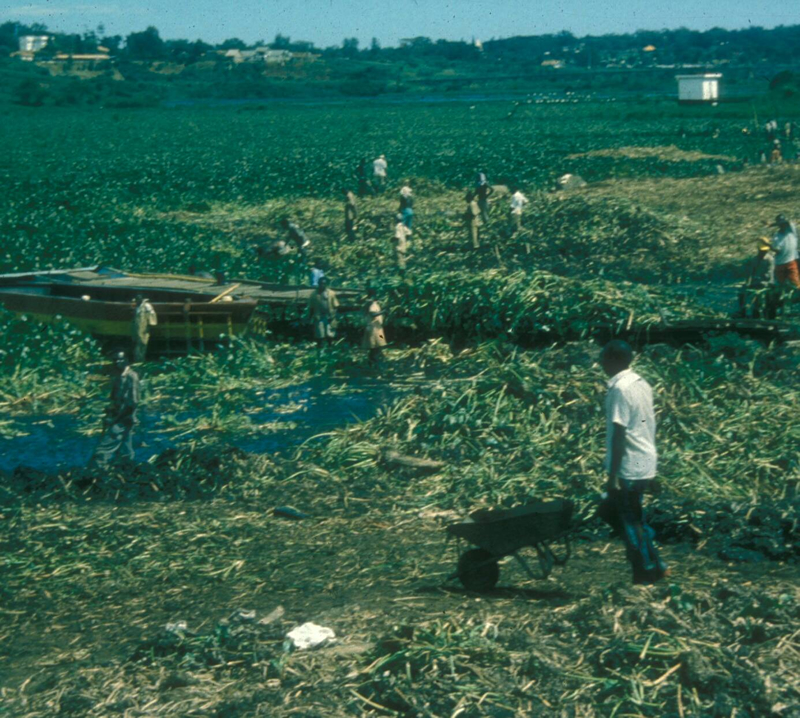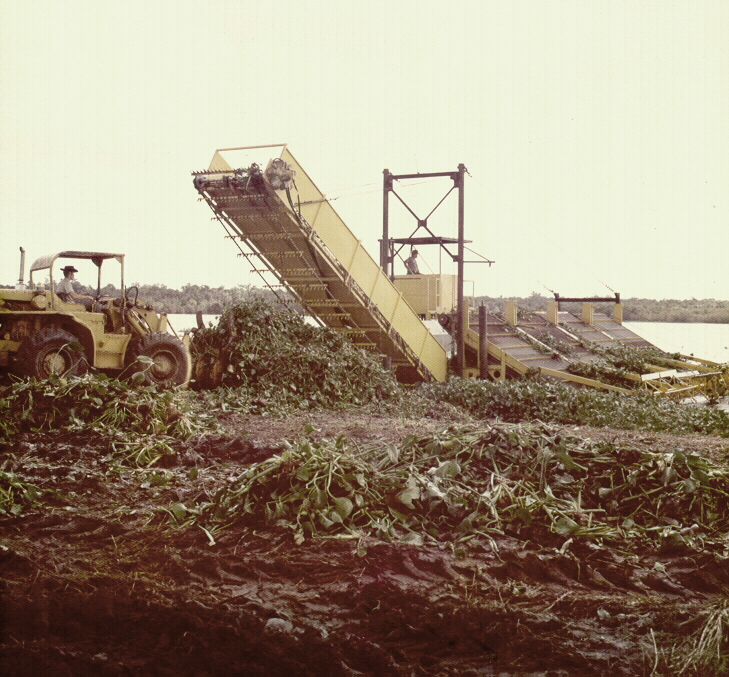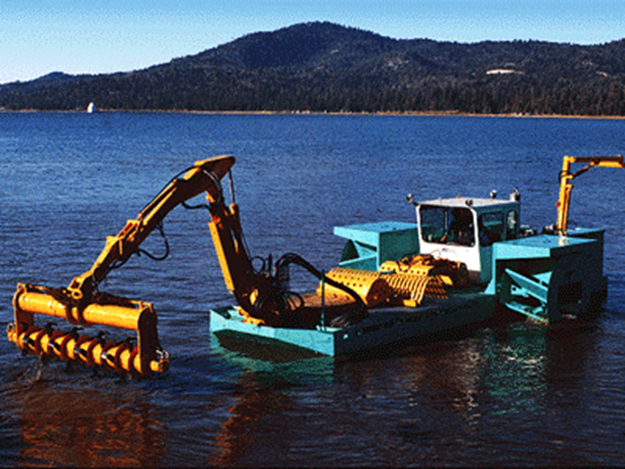Mechanical control of exotic plants may include methods such as hand pulling, manual cutting, harvesting, rolling, rotovating, dredging, and the placement of barriers to inhibit growth. Several of these techniques, such as hand pulling, manual cutting, and rolling are used in small scale projects or individual waterfront lots. Harvesting, rotovating and dredging are used in larger scale aquatic weed removal.
 Hand pulling aquatic weeds is similar to weeding your garden. The individual attempts to remove the entire plant, including roots, while leaving the beneficial species intact. This technique works best in softer sediments, with shallow rooted species and for smaller infestation areas. But, as with garden weeding, this process must be repeated often to control regrowth. Additionally, the disturbance of the sediment may result in murky water, thus making it difficult to see the remaining plants. When hand pulling nuisance species, the individual should take care to remove the entire root system and collect all of the plant fragments since even small root or stem fragments could result in additional growth of the species. One point to keep in mind is that aquatic plants act to retain sediment around their roots and lower stems. The removal of these plants may result in increased erosion along the shoreline since there would no longer be any roots holding the sediment in place. It is suggested that native species be replanted in place of the exotics which have been removed. This will not only act to stabilize the shoreline, but also inhibits the regrowth of some exotic species.
Hand pulling aquatic weeds is similar to weeding your garden. The individual attempts to remove the entire plant, including roots, while leaving the beneficial species intact. This technique works best in softer sediments, with shallow rooted species and for smaller infestation areas. But, as with garden weeding, this process must be repeated often to control regrowth. Additionally, the disturbance of the sediment may result in murky water, thus making it difficult to see the remaining plants. When hand pulling nuisance species, the individual should take care to remove the entire root system and collect all of the plant fragments since even small root or stem fragments could result in additional growth of the species. One point to keep in mind is that aquatic plants act to retain sediment around their roots and lower stems. The removal of these plants may result in increased erosion along the shoreline since there would no longer be any roots holding the sediment in place. It is suggested that native species be replanted in place of the exotics which have been removed. This will not only act to stabilize the shoreline, but also inhibits the regrowth of some exotic species.
Manual cutting, of exotic weeds, is similar to mowing your yard. Weed cutters are commercially available. These tools consist of two blades in a "V"-shape with a rope tied to them. Home-made weed cutters can be constructed from a sturdy rake head, such as an asphalt rake, tied to a rope in a similar manner. It is thrown into the weeds and pulled to shore. The plants are cut and float to the surface. The individual must then collect the plant fragments and remove them to an upland site to insure that they do not recolonize adjacent areas. Like lawn mowing, this method will not remove the plants from an area, it is only meant to reduce the extent of their growth. Mechanical harvesters are large machines which cut and collect aquatic plants. These machines can cut the plants from five to ten feet below the water surface and may cut a swath between 6 and 20 feet wide. The weeds are cut and collected by the harvester and may be retained or deposited in a barge. The vegetation is then transferred to an upland disposal site. The advantage of this type of aquatic weed control is that it immediately opens an area such as boat lanes. It also removes the upper portion of the plant while leaving the lower portion for habitat enhancement.
 Due to the large size of the equipment, mechanical harvesting is limited to water areas of sufficient size and depth. Mechanical harvesting results in fragments of the plant which, if not captured by the harvester, must be hand collected to eliminate the possibility of spreading the plant to new areas. Additionally, harvesters may impact fish and insect populations in the area by including them in the harvested material. The use of harvesters is fairly expensive and has to be performed several times per growing season to maintain control of the nuisance weed. The price per acre may range from $500-$800 dollars, excluding mobilization, and the cost for the equipment could exceed $100,000.
Due to the large size of the equipment, mechanical harvesting is limited to water areas of sufficient size and depth. Mechanical harvesting results in fragments of the plant which, if not captured by the harvester, must be hand collected to eliminate the possibility of spreading the plant to new areas. Additionally, harvesters may impact fish and insect populations in the area by including them in the harvested material. The use of harvesters is fairly expensive and has to be performed several times per growing season to maintain control of the nuisance weed. The price per acre may range from $500-$800 dollars, excluding mobilization, and the cost for the equipment could exceed $100,000.
Weed Rollers are a fairly new method to control nuisance weed populations. This type of equipment works on the principle that if you roll over an area frequently enough the plants will die, similar to trails produced in yards by human and pet traffic. The roller, which can be up to 30-feet long, is powered by an electric motor and is anchored in place. It travels forward and reverse in a 270 degree arc around its anchor position and compresses the plants and soil in the area. This type of equipment is low effort on the operators part and can be left in place and used as the plants begin to grow. Frequent use of the roller should maintain a low amount of weed growth in the area being rolled. The use of rollers may disturb bottom dwelling organisms and spawning fish. Additionally, fragmentation of the nuisance plant may occur. Also, the equipment should not be used when people are swimming or wading in the area due to the potential for injury.
 A rotovator is similar to under-water rototiller. The equipment has rototiller-like blades which turn seven to nine inches below the bottom to dislodge and remove roots. The plants and roots can then be removed either manually or with a rake attachment. This method of plant removal works best when the plants are shorter since longer plants tend to wrap around the spinning blades and may damage the equipment. Due to the size of the equipment and high costs, this method is best suited for larger waterbodies. Since the rotovator greatly disturbs the sediment, there are several environmental considerations to look at; will the rotovator resuspend contaminated sediments, release nutrients locked-up in the soil, adversely impact benthic (bottom dwelling) organisms, and will it impact fish spawning areas. This method is useable year-round and has been shown to be very effective in rapidly clearing areas and maintaining low levels of weed growth for several seasons. However, similar to rototillers, rotovating should be used in waterbodies with few obstructions since encountering rocks, logs, or other debris could damage the equipment.
A rotovator is similar to under-water rototiller. The equipment has rototiller-like blades which turn seven to nine inches below the bottom to dislodge and remove roots. The plants and roots can then be removed either manually or with a rake attachment. This method of plant removal works best when the plants are shorter since longer plants tend to wrap around the spinning blades and may damage the equipment. Due to the size of the equipment and high costs, this method is best suited for larger waterbodies. Since the rotovator greatly disturbs the sediment, there are several environmental considerations to look at; will the rotovator resuspend contaminated sediments, release nutrients locked-up in the soil, adversely impact benthic (bottom dwelling) organisms, and will it impact fish spawning areas. This method is useable year-round and has been shown to be very effective in rapidly clearing areas and maintaining low levels of weed growth for several seasons. However, similar to rototillers, rotovating should be used in waterbodies with few obstructions since encountering rocks, logs, or other debris could damage the equipment.
Dredging of weed infested areas is usually not practical unless it is in conjunction with boat channels or canals. Hydraulic or clam shell dredges will remove a large amount of sediment along with the vegetation and therefore a suitable disposal site must be present nearby. Dredging results in similar problems with suspended sediment and habitat impacts as explained above with rotovating and harvesters.
The placement of barriers has not been demonstrated to be as effective in aquatic weed control as other methods. This method consists of the placement of sheets of plastic or other material on the bottom over the plants. By eliminating the sunlight from the area the plants cannot photosynthesize and therefore die. This control method will also result in the loss of habitat for benthic organisms due to the loss of bottom areas. Additionally, as sediment builds up on the sheet or tears are created, the nuisance plant may recolonize the area.
Research and Development Aquatic Plant Information System (APIS) Engineer Center USACE APIS Home Page.